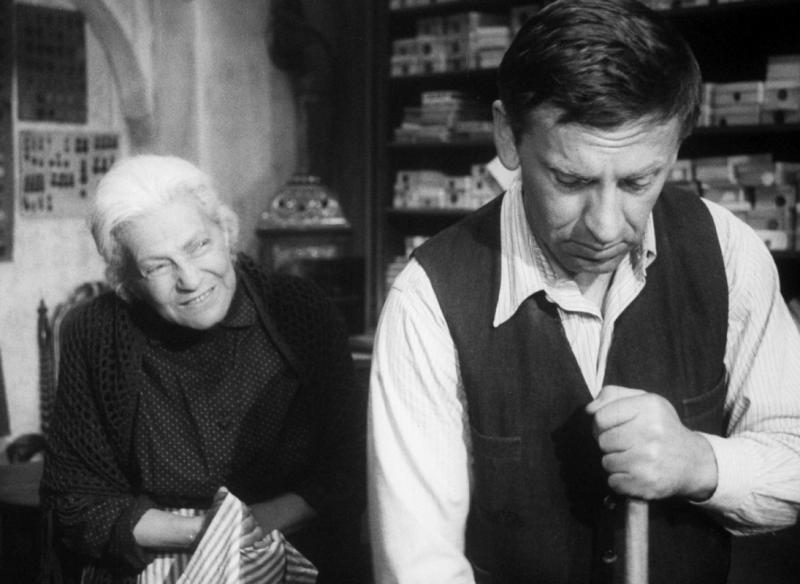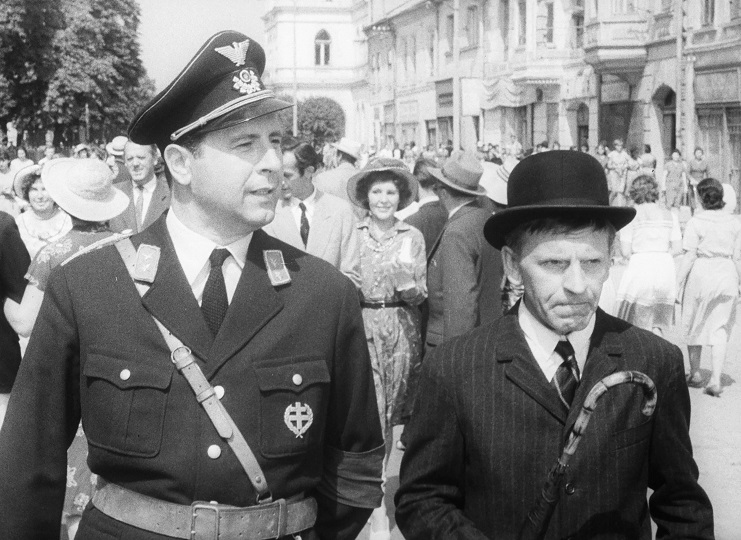DVD: The Shop on the High Street | reviews, news & interviews
DVD: The Shop on the High Street
DVD: The Shop on the High Street
Peerless Slovak Holocaust drama brings comedy into tragic context

There will surely be no end to the debate as to how any work of art can approach treating the Holocaust, and its depiction in cinema, with the great immediacy of that form, has always been especially problematic.
Kadár and Klos’s film achieves that rarest thing, the convincing introduction of elements of comedy into a context where it might seem impossible, heightening rather than diminishing the overall emotional effect. At its heart is the interrelationship between a simple Slovak carpenter, “Tóno” Brtko (Jozef Kroner), and the elderly Jewish widow Rozalie (Idá Kaminská) which develops when the former is appointed “Ayran controller” of the small haberdashery store that she owns, which gives the film its title.
It stands out for the dynamic of its central acting pair
Rozalie’s age and deafness mean that she simply cannot comprehend that the Slovak has been appointed essentially to appropriate her business, and Tóno becomes easily acquiescent in maintaining her ignorance of the real situation. Set in 1942, the film catches the abrupt transition from a time when the Jews were still allowed to live almost as before to the moment of their despatch to the concentration camps. Tóno’s final agonies in his attempts to save his unlikely charge bring home the degree to which his society has totally ignored what has been happening until it is too late.
The depiction of the smug self-interest of the local population, driven on by the Hlinka Guard – the local equivalent of the SS in the nominally independent Slovak republic – is unsparing, not least in the portrayal of Tóno’s wife and immediate family: his brother-in-law has become a senior figure in the new regime, and sees getting rich from anti-Jewish activity as a “duty to God, the Fuhrer, and the Republic” (Kroner with František Zvarík, pictured below). The fact that such social satire, as well as the essentially innocent, almost “slacker” figure of Tóno, is familiar in Czechoslovak culture makes its context here all the more unsettling.
 Winner of the 1965 Oscar for Best Foreign Language Film, the film put a new generation of Czechoslovakian cinema on the international map, even if Kadár and Klos were older than the directors whose names we associate today with the Czech New Wave, and The Shop on the High Street looks quite traditional in form by comparison with other work from the time. Indeed, its harking back to images of small-town life – complete with the brass band that makes up part of composer Zdeněk Liška’s remarkable score – is all the more powerful for the way in which we see reality subverting such stereotypes.
Winner of the 1965 Oscar for Best Foreign Language Film, the film put a new generation of Czechoslovakian cinema on the international map, even if Kadár and Klos were older than the directors whose names we associate today with the Czech New Wave, and The Shop on the High Street looks quite traditional in form by comparison with other work from the time. Indeed, its harking back to images of small-town life – complete with the brass band that makes up part of composer Zdeněk Liška’s remarkable score – is all the more powerful for the way in which we see reality subverting such stereotypes.
It stands out for the dynamic of its central acting pair, the indecision of Kroner’s character set against the almost otherworldly innocence of Kaminská (the actress was actually Polish, and had been a legend of Yiddish theatre: nominated separately in 1966 for Best Actress, she lost to Elizabeth Taylor in Who’s Afraid of Virginia Woolf?).
This Second Run release presents a new 2K restoration, giving new crispness to the images, and is accompanied by an exemplary 40-minute filmed appreciation by film historian Michael Brooke that is brisk and enthusiastic, and a booklet essay by film expert Peter Hames. Brooke reminds us that The Shop on the High Street is definitely a Slovak rather than Czech film, and gives fascinating historical context on the period in which it is set in that country.
rating
Explore topics
Share this article
The future of Arts Journalism
You can stop theartsdesk.com closing!
We urgently need financing to survive. Our fundraising drive has thus far raised £33,000 but we need to reach £100,000 or we will be forced to close. Please contribute here: https://gofund.me/c3f6033d
And if you can forward this information to anyone who might assist, we’d be grateful.

Subscribe to theartsdesk.com
Thank you for continuing to read our work on theartsdesk.com. For unlimited access to every article in its entirety, including our archive of more than 15,000 pieces, we're asking for £5 per month or £40 per year. We feel it's a very good deal, and hope you do too.
To take a subscription now simply click here.
And if you're looking for that extra gift for a friend or family member, why not treat them to a theartsdesk.com gift subscription?
more Film
 Blu-ray: Eclipse
The BFI has unearthed an unsettling 1977 thriller starring Tom Conti and Gay Hamilton
Blu-ray: Eclipse
The BFI has unearthed an unsettling 1977 thriller starring Tom Conti and Gay Hamilton
 The Ballad of Wallis Island review - the healing power of the old songs
Estranged folk duo reunites in a classy British comedy drama
The Ballad of Wallis Island review - the healing power of the old songs
Estranged folk duo reunites in a classy British comedy drama
 The Salt Path review - the transformative power of nature
Marianne Elliott brings Raynor Winn's memoir to the big screen
The Salt Path review - the transformative power of nature
Marianne Elliott brings Raynor Winn's memoir to the big screen
 Bogancloch review - every frame a work of art
Living off grid might be the meaning of happiness
Bogancloch review - every frame a work of art
Living off grid might be the meaning of happiness
 When the Light Breaks review - only lovers left alive
Tender close-up on young love, grief and growing-up in Iceland
When the Light Breaks review - only lovers left alive
Tender close-up on young love, grief and growing-up in Iceland
 Blu-ray: Strange New Worlds - Science Fiction at DEFA
Eye-popping Cold War sci-fi epics from East Germany, superbly remastered and annotated
Blu-ray: Strange New Worlds - Science Fiction at DEFA
Eye-popping Cold War sci-fi epics from East Germany, superbly remastered and annotated
 Mongrel review - deeply empathetic filmmaking from Taiwan
Artful direction and vivid detail of rural life from Wei Liang Chiang
Mongrel review - deeply empathetic filmmaking from Taiwan
Artful direction and vivid detail of rural life from Wei Liang Chiang
 The Phoenician Scheme review - further adventures in the idiosyncratic world of Wes Anderson
Benicio del Toro's megalomaniac tycoon heads a star-studded cast
The Phoenician Scheme review - further adventures in the idiosyncratic world of Wes Anderson
Benicio del Toro's megalomaniac tycoon heads a star-studded cast
 Mission: Impossible - The Final Reckoning review - can this really be the end for Ethan Hunt?
Tom Cruise's eighth M:I film shows symptoms of battle fatigue
Mission: Impossible - The Final Reckoning review - can this really be the end for Ethan Hunt?
Tom Cruise's eighth M:I film shows symptoms of battle fatigue
 Magic Farm review - numpties from the Nineties
A comedy about youth TV putting trends above truth
Magic Farm review - numpties from the Nineties
A comedy about youth TV putting trends above truth
 Good One review - a life lesson in the wild with her dad and his pal
A wise-beyond-her-years teen discovers male limitations in a deft indie drama
Good One review - a life lesson in the wild with her dad and his pal
A wise-beyond-her-years teen discovers male limitations in a deft indie drama
 E.1027 - Eileen Gray and the House by the Sea review - dull docu-fiction take on the designer-architect
Iconic Irish modernist Eileen Gray gets an artsy and overly reverential appraisal
E.1027 - Eileen Gray and the House by the Sea review - dull docu-fiction take on the designer-architect
Iconic Irish modernist Eileen Gray gets an artsy and overly reverential appraisal

Add comment